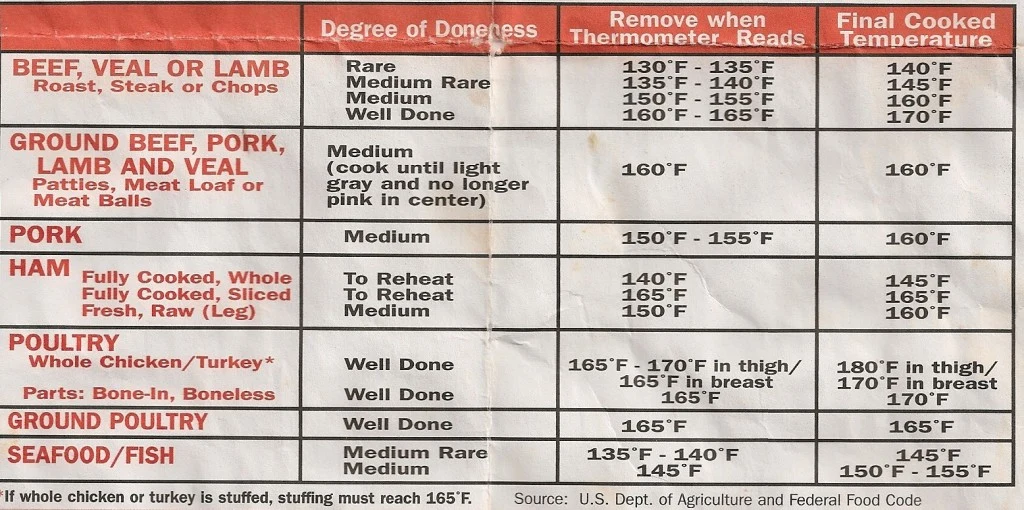I originally wrote this post about two years ago, but it has stood the test of time and is topical for this time of year: outdoor grilling season!
Even though I have been grilling for years and years, there are still times I rely on my meat thermometer to make sure thangs are done and no one walks away from the table sick. The horror!
Using a quick-read meat thermometer is easy peasy. Let’s make sure we’re doing it right, shall we?
How To Use a Meat Thermometer in Two Easy Steps:
1) Insert thermometer into the center of the thickest part of the meat. If need be, insert thermometer horizontally. Thermometer should not be touching bone or fat.
2) Wait 10-15 seconds before reading.
BAM! You’re now an expert in meat thermometers. Easiest tutorial, evah!
Here’s a scan of the “degree of doneness” chart I use to determine safe grilling temps (this can also be used as a guide for indoor cooking):
Technically, the thermometer should be inserted two inches and there’s a very good reason for that. Quick-read thermometers sense temps from the start of the tip to the end of the probe. Two inches allows for an average temp along that area. Remember, if you can’t get a good probe from the top of your meat, go horizontally. (anyone else snickering like a 12-year-old boy?!)
Do I do two inches every time? No. But, the caveat here is that I’m a veteran cook and also use my sense of touch, smell and sight to determine doneness. If you’re just starting out and learning how to cook, using a quick-read meat thermometer will ensure food safety.
DON’T KILL GRANDMA AT SUNDAY BRUNCH!
~ A gentle reminder: OMT! uses Amazon referral links. When you do your shopping through the Amazon links on this page, you support the blog at no cost to yourself. It’s much appreciated!~
Here’s the thermometer I use:
(image source: Amazon)
Product Deets:
It’s easy to read and I like that it’s old school (but you may prefer a digital reader). I had to replace my original after I misplaced it, but it worked for years and never failed me. I love a simple inexpensive product that produces over and over.
One more thing, and this is important: after you’ve inserted the thermometer into the meat and it isn’t done yet, make sure and thoroughly wash the thermometer before inserting again. You don’t want to transfer any bacteria from probe to probe (seriously…stop laughing!) that will make you sick.
Happy Grilling, Y’all!


Jennifer S
Sunday 12th of July 2015
Am I a horrible wife if I admit that we don't even own a meat thermometer? ... gonna have to get me one of them this week!
Patti Tucker
Monday 13th of July 2015
Ha! No! It is a helpful tool, but maybe you have it done cold!
Alicia
Saturday 11th of July 2015
Maybe this would help our seeks turn out better ;)
Patti Tucker
Sunday 12th of July 2015
Always a possibility!
Stacie
Friday 10th of July 2015
My husband does the grilling around here. I should definitely get him one of these! Stacie xo
Patti Tucker
Friday 10th of July 2015
It's a nice tool to have in the grilling box o'tricks!
Talya Tate Boerner
Friday 10th of July 2015
I always use one with chicken. Undercooked chicken freaks me out.
Patti Tucker
Friday 10th of July 2015
Nothing worse on a plate than undercooked chicken. ugh!